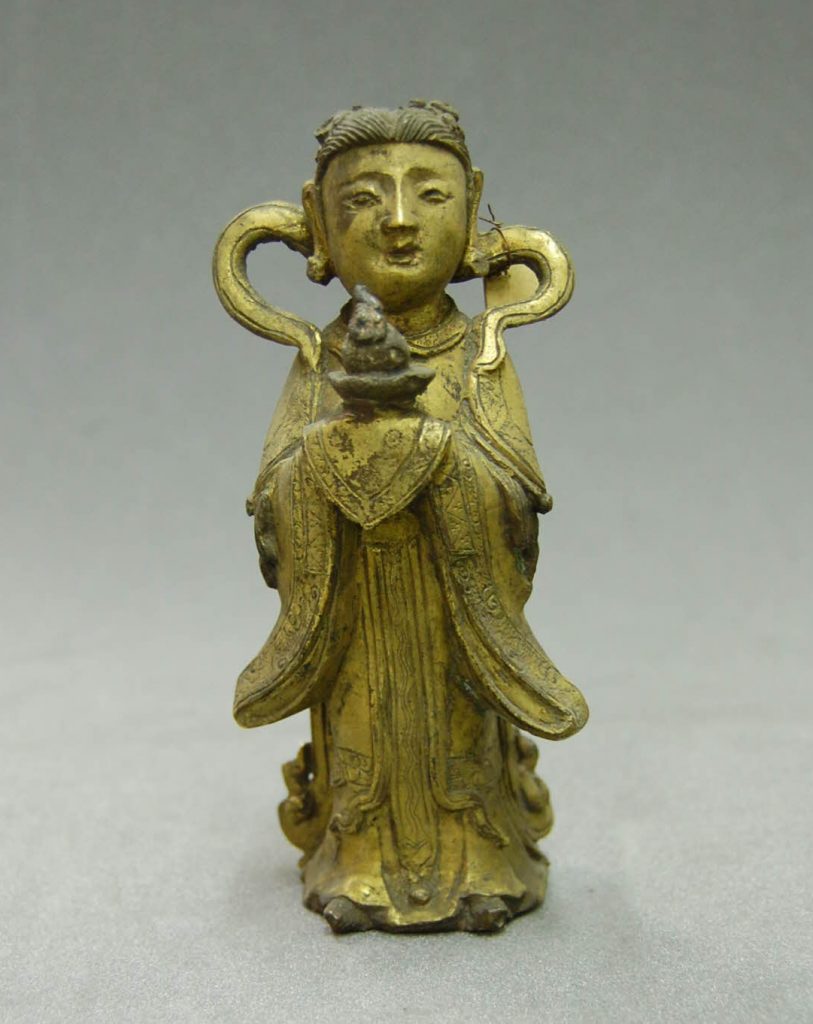
“Figure (girl), made of gilded bronze.” Qing Dyntasy, China, circa 1700s. Held by The British Museum.
A young girl made of bronze, holding an object we can’t identify, pleading with us to call her by name.
That seems to be the story of so many girls in Qing China, the last imperial dynasty of an ancient land. The Qing dynasty lasted from 1644 until 1912, becoming known as a multicultural empire that formed the basis for modern China. Yet it was a rigid society, known for its strict class hierarchy and the oppression of women.
Like this nameless girl, many girls in the Qing dynasty were expected to be silent. Though educated, it was only so that they could take their place as teachers of morality. A girl’s education was only needed so that she could teach her sons how to behave and properly manage her husband’s household. She was expected to dwell inside her home, morally uphold her family, and instill moral values into her children.
Yet it was her home – a complexity of extended relations, nurses, and servants – as well as the education she was afforded that would ultimately help her find her voice. Family life wasn’t rigid – it was fun and loving, much like many girls experience today. While a girl’s mother oversaw the household and taught her the skills she would need to become a wife, her mother would also encourage her to memorize poetry and primers. Her father also had some role in her education, but many accounts describe fathers playing with their children each day. So a Qing girl would have grown up in a loving, nurturing home – where her role and education were valued.
This complexity is what led Qing girls to ultimately be complex figures themselves. Expected to be silent, they were never truly quiet. Expected to uphold tradition, it was classical tradition that would rescue them.
This classical tradition was under constant scrutiny during the Qing dynasty. The more scholars studied the classical teachings, the more women’s roles were challenged in society. Eventually, many came to believe that girls could be educated purely to be creative, and that societal standards should be ignored when a girl showed exceptional promise in her studies or creativity. “Child prodigy” was now a viable career choice for girls.
This new standard helped liberate girls who were not child prodigies as well. The Qing dynasty quickly came to believe that once a girl had done her duty as a wife and mother, she was free to pursue her own interests. Qing girls grew into independent, creative women who indulged in poetry, art, and music.
By the 1800s, Qing girls were no longer secluded in their homes. The complexity of their family lives had broken free into the real world, as the Qing dynasty established girls’ schools, made imperial reforms, and came to believe that girls could be creative, independent individuals contributing to society as more than simply wives and mothers. Like this girl someday will, Qing girls had finally found their voices.
-Tiffany Rhoades
Program Developer
Girl Museum Inc.
This post is part of our 52 Objects in the History of Girlhood exhibition. Each week during 2017, we explore a historical object and its relation to girls’ history. Stay tuned to discover the incredible history of girls, and be sure to visit the complete exhibition to discover the integral role girls have played since the dawn of time.
